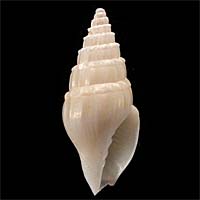|
< Previous family introduction |
|
|||||
 |
Family Volutomitridae | |||||
|
The numerically small family Volutomitridae contains shells which are intermediate in character between the Mitridae and the Volutidae. They have a mitre-shaped shell, with large plaits on the columella, but a radula similar to that of the volute genus Scaphella. Some genera in the family are operculate, in contrast to the Mitridae and Costellariidae where an operculum is absent. The group has been placed as a subfamily of the Mitridae and the Volutidae at various times; it was elevated to family status by Cernohorsky in his revision of the group. Species occur in sand and mud at depths of 10-1,900 metres, living in water temperatures of -1 to 10 degrees centigrade. One species occurs intertidally in new Zealand, but all others live entirely subtidally. Having a feeding structure similar to the Mitridae, it is assumed that they are carnivorous, but the actual prey is unknown. The family contains 24 living species plus 66 fossil species. In Australia, there are nine species recognized, with four of these occurring in NSW. One of these, Microvoluta miranda, lives at depths down to 1,097 metres and although named in 1891, has only been commonly seen in the last two decades. All species are uncommon in collections, although some appear to be common in their deep water habitat. Family Reference Cernohorsky, W.O. 1970. Systematics of the families Mitridae and Volutomitridae (Mollusca: Gastropoda). Bulletin of the Auckland Institute and Museum 8:1-190 Coverage All species of the family that occur in NSW are treated in detail here. Identification notes Volutomitrids in NSW are small, up to 13 mm in length, with a mitre-shaped shell with large plaits on the columella. In this family the first (i.e. most posterior) fold is smaller and shorter than the second, but in the NSW species the different in size is so small as to not be noticeable. Shells are smooth, or with axial folds.
|